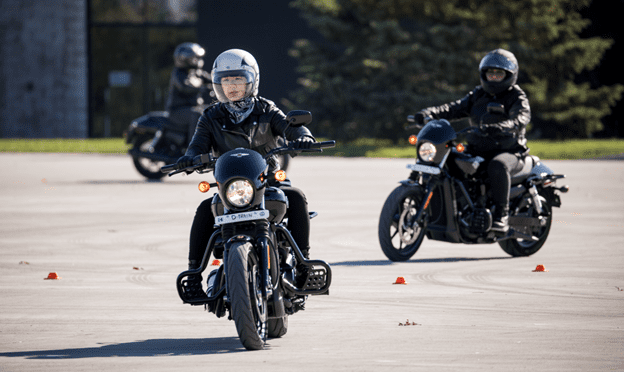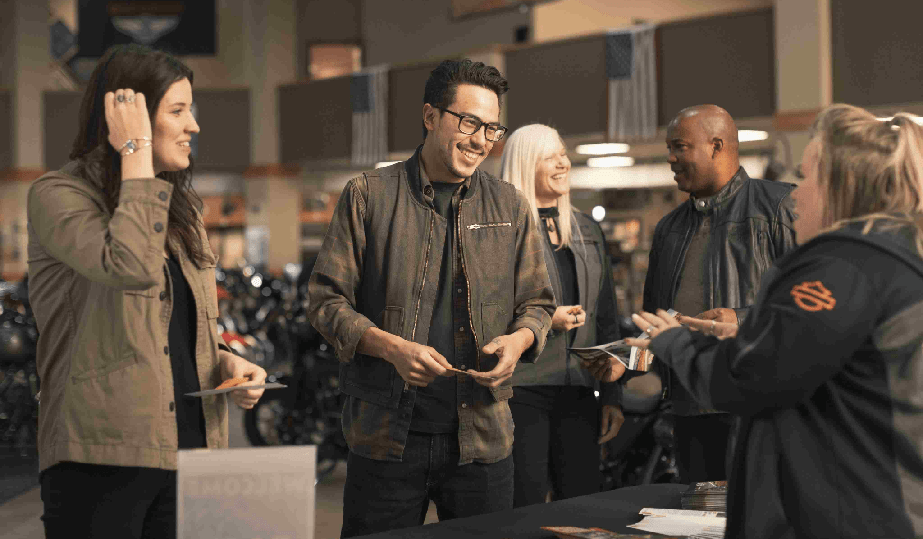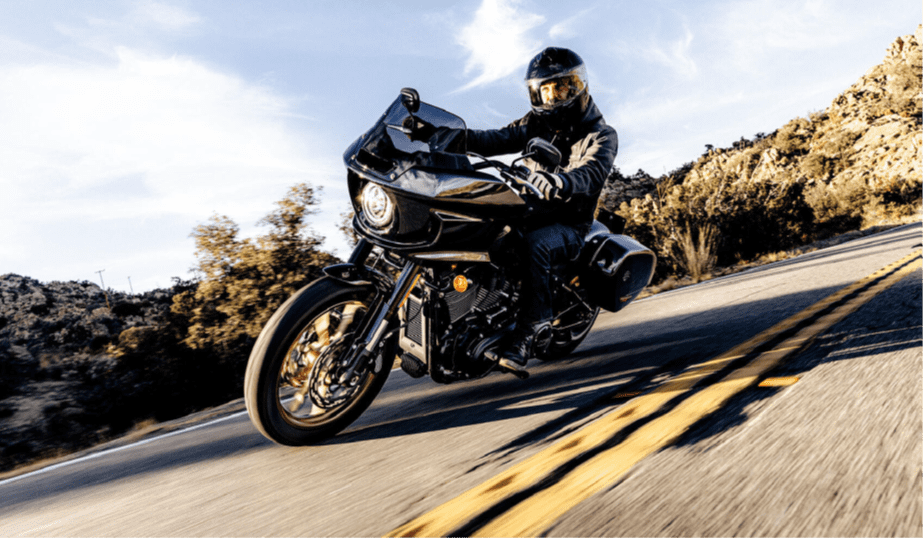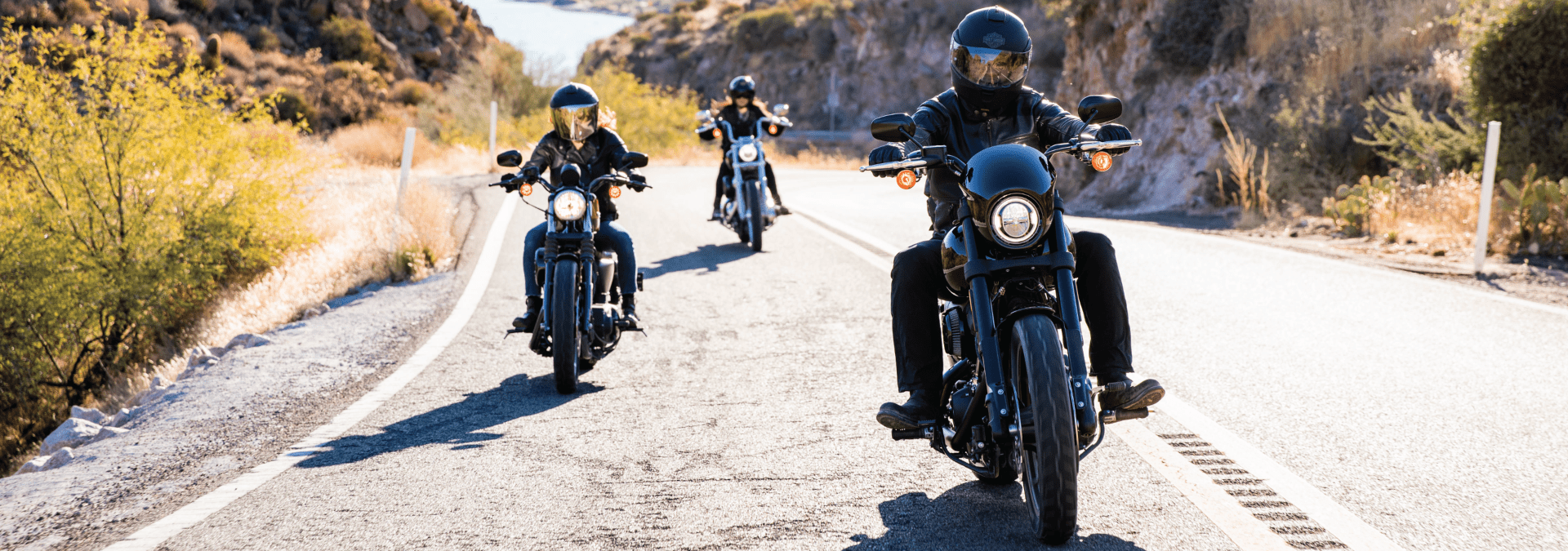-
Harley-Davidson® Riding Academy
Whether you're just getting started or just brushing up, learn the skills you need to ride with confidence. We've helped hundreds of thousands of riders achieve their dreams, let us help you too. Learn more about our Harley-Davidson® Riding Academy motorcycle training courses and find a class today.
-
-
NEW RIDER COURSE
Never ridden before? Want to get your license? The New Rider Course will lead you through the steps to learn to ride a motorcycle and get you on the road. Successful completion earns the MSF BRC card and in most states a license waiver that gets you a motorcycle endorsement on your license at your state DMV.
find a class -

-
-
-
WHAT TO EXPECT
-
Learn to ride on a genuine Harley-Davidson® motorcycle
-
Classroom and range instruction from state & Riding Academy certified coaches
-
Learn to safely accelerate, shift, brake, and turn, along with maneuvers like controlling skids and surmounting riding obstacles
-
Earn a Motorcycle Safety Course Completion Card, which may exempt you from the riding portion of your state license exam and score you a discount on motorcycle insurance
-
-
-
-
NEW GRADUATE FINANCING AVAILABLE
Riders who complete the Harley-Davidson® Riding Academy Course can take advantage of special financing options which include no down payment or rates as low as 3.49%* and flexible terms.
Learn More -
-
GET READY TO RIDE
Take the guess work out of preparing for class with our free Get Ready to Ride Orientation. Get fitted with the right gear, practice motorcycle controls on our stationary bike, and take a tour of the dealership so you're ready for your first day of class.
Sign up here -

-
-
-
YOUR JOURNEY IS JUST BEGINNING
You're on your way to becoming a fully licensed rider. The open road is calling, and we can't wait to help you answer the call. Check out our additional opportunities to learn and gain confidence and hear from our students about their experiences.
Watch more -
-
-
-
WELCOME BACK WORKSHOP
The fun doesn't stop once class ends. We offer free post class Welcome Back Workshops for all Riding Academy graduates and guests here at the dealership. Learn more about motorcycling from our trained staff and join us for demos, activities, food, prizes and more!
Sign up here -

-
-
-
INTERMEDIATE RIDER LICENSING COURSE
Created for experienced riders, this 1-2 day course offers advanced tips and techniques that help you own the road. The course is built on the curriculum of the Motorcycle Safety Foundation® (MSF) Basic Rider Course 2 Suite, and is taught by devoted MSF and H-D™ Certified Instructors.
FIND A CLASS -

-
-
Most frequently asked questions
After enrolling, you should be contacted by your dealership with any specifics to your course, including what to bring, what is required, and where and when to meet. Some dealers will have the coach call you, welcome you, remind you of items to bring and answer any questions you might have about the class.
Many states use the Motorcycle Safety Foundation curriculum and many of those employ the MSF Basic eCourse as a component of your overall class. The eCourse replaces a classroom session at the dealer and can easily be completed at your convenience prior to the first night of class. Look through your welcome email and if the dealer sent a link to the MSF Learning Center(Note: You may be required to pay a separate fee if the dealer did not include this in your class fee).
Be sure to budget time prior to the first day of class to complete the eCourse - it takes about 3 hours, and even if you have previous experience with motorcycling, you cannot fast forward through any sections of the eCourse. You will receive a completion certificate at the end of the course, be sure to print that out and bring it to the first day of class.
You will need to bring these items to class with you
- Your Driver's License and/or Learner's Permit
- Proof of completion of any pre-required course study
- Any materials provided to you prior to or during class
Motorcycle gloves and a motorcycle helmet are the only essential motorcycle specific items, but we recommend that sometime before the first night of class, take what you have to the dealer to get it checked out. They can help you ensure that you have the right motorcycle gear.
CLASS GEAR LIST
- Long-sleeve shirt or jacket
- Long pants (heavy denim or riding pants recommended)
- Over-the-ankle boots (sturdy, not canvas, low heel)
- Eye protection (helmet visor, eye glasses, sun glasses, goggles acceptable)
- Full-finger gloves (motorcycle specific recommended)
- DOT-certified helmet style based on the requirements of your state
SHOPPING FOR A HELMET
A helmet is the most important piece of motorcycle gear you will invest in. A helmet is a very personal piece of gear. Consider buying a helmet vs. borrowing one, that way it is yours and it fits you perfectly and allows you to focus on learning to ride.
The staff at your dealer are trained to fit a helmet and will ensure you get the right one. Helmet fit is so important that they will most likely suggest you wear the one you settle on around the dealer for about 15 minutes. It takes that long for the helmet to really let you know if it will be comfortable in the long run. Remember, helmets are not typically returnable once they leave the dealership, so take the time to find the right one.
Coach Tip: The more helmet the better, full face is the best, followed by a modular. An open face helmet or ¾ open still provides good protection if you feel too cooped up in a full face. Half helmets, while very popular, offer the least amount of protection.
There are a variety of schedules. This example of a typical weekend course will give you a feel for what to expect.
The first class meeting typically runs three hours: You'll get a tour of the dealership, fill out all the class paperwork and get to know your peers and coaches. During the paperwork session, you will hear a lot about counseling and being on time and having all the gear. Don't fret, it is just to set clear expectations for everyone. Being that an endorsement waiver is provided through this class, it has some structural aspects that the state requires to allow for licensing.
You'll get a ROADBOOK - this is a small Harley-Davidson® Journal that you will use to reflect on important points throughout the class. A review of the eCourse will be next, which gives you a chance to better understand important points of the eCourse. Jump in there and participate! A lot of what is being discussed you have already seen firsthand as a car driver. Then the class will turn to new material - an activity to help demystify motorcycle controls and their use will be held, as well as an activity to help understand important aspects of riding gear.
At the end of the night, coaches usually spend some time talking about the range days, what to bring, where the range is and when to be there. The range is simply a practice lot; it is a large flat piece of pavement that may be on dealer property or down the road a few miles.
This site is usually blocked off from car traffic and offers a controlled environment to learn in. The classroom will probably conclude with a discussion on the range rules and hand signals. These are all intended to help you understand how the range works and to ensure everyone has a good time during the riding portion of the course.
Coach Tip: If you are not sure where the range is, take time to drive by it on the way home versus frantically searching for it in the morning.
Pack whatever snacks you need to keep going physically and mentally, bottled water is usually provided by the dealership.
A typical course will include two days on the range. Here is what to expect.
FIRST DAY RIDING
Your first range day will focus on getting to know the motorcycle, how to properly start it up, move it from point A to point B, and shut it off. You learn the fundamentals of clutching and shifting, turning and stopping.
Each exercise is designed to build on the previous exercises and allow you to learn quickly and effectively. Expect each exercise to take about 40 minutes. After every other exercise, a break will be held. This is usually a ROADBOOK opportunity and a chance to just rest, get a drink of water and hang out with your classmates.
Programs typically hold a classroom session at the dealership after the first range day. The afternoon classroom session is focused on behaviors and self-assessment. This is important stuff! The more you participate the more you will get out of it.
Coach Tip: Learning to ride can be mentally and physically exhausting. Make plans to rest Saturday night - you want to be fresh for the second range day.
SECOND DAY RIDING
Day 2 will focus on the skills of riding: cornering, swerving and maximum braking. Just like the first day, expect two exercises back to back with a ROADBOOK break in between. These exercises are at slightly higher speeds than yesterday's and are a lot of fun! Expect to see smiles spread across the faces of your classmates.
At the end of the second day on the range, the coaches will set up and score the five evaluation exercises. These are based on the same exercises you just rode and the same skills you learned over the last two days of riding.
Relax and be sure to breathe - This is just a fair measurement of your current abilities to ensure that you are ready to leave the range and venture out onto the open road. Listen to your coaches and watch each student ahead of you as they ride the test exercises. You want to be sure of the path of travel and the technique being scored.
Coach Tip: Don't score yourself during the evaluations. Not all areas of the riding exercise are scored, and most mistakes are just a few points. Riders that get worked up because they made a riding error often ride worse and make more errors. Ride on and do your best!
At the end of the evaluations, your coach will let you know how you did. If you did not pass, don't freak! There are often opportunities to take a portion of the course over or to retest later. See your Riding Academy Manager as soon as possible regarding these options.
On the last classroom meeting there might be state specific content to cover, more paperwork to complete and some celebrating to do. This is it, you are in the family now, enjoy the ride!
Students who successfully complete the classroom and range sessions will be issued a completion document. In many states this document will excuse the person from taking a motorcycle operator skills test through the Department of Motor Vehicles. However, it does not count as a license and is not recognized by law enforcement as a license to ride. Your Coach or your local DMV will provide you with instructions on steps to take to convert the completion document into a license.
You will need to take your completion document to your DMV and complete any additional steps required to get the motorcycle endorsement on your driver license. Once you've gotten your license, get out and enjoy the ride!
Black Wolf Harley-Davidson®
1061 Old Abingdon Hwy
Bristol, VA 24201
US
Phone: 276-644-9653
Email: jpope@blackwolfhd.com,DLPparsing@sfe-us.com,Leads@dlpspeed.com
Fax:


